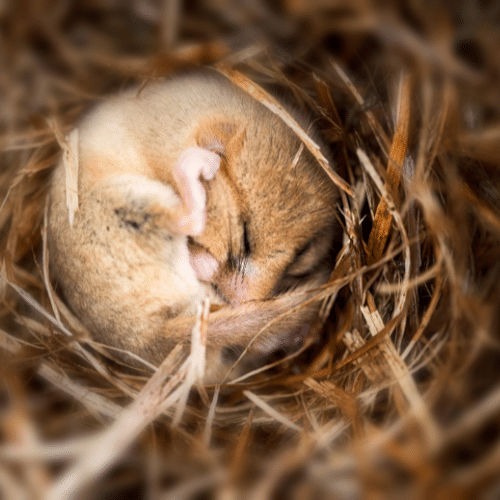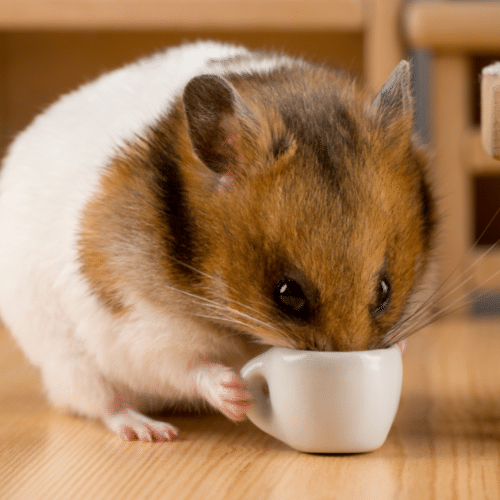If you provide everything to your pet hamster, then y our little friend has a lot of things to keep him occupied, from wheels to tunnels and everything in between. But remember, they hibernate. It is in their natural ability to do so.

Let’s discuss hamsters’ hibernation and its signs.
5 Hamster Hibernation Signs
- Slowed Breathing
The rate at which your hamster breathes will significantly decrease when it is hibernating. If you only give your hamster a quick check, it will most likely give the impression that it has entirely ceased breathing.
If you look more closely, though, you should be able to see some indications that your hammy is still breathing, even if it appears to be dead. Take a look at his chest and see if you can make out a tiny expansion there.
In addition, you should pay attention to your hamster’s whiskers and nose since they may twitch. You might also try approaching your hamster from a closer distance to determine whether you can hear it breathe.
- Shivering
Signs that a hamster is about to hibernate can be observed well ahead of the actual hibernation. One of them is because the temperatures are beginning to get lower/colder. Your hamster won’t be able to tolerate temperatures that are too low (or beyond the range of a hamster normal body temperature celsius). As a result, when this occurs, it will begin to hibernate.
Therefore, your best chance in this situation is to maintain your hamster’s environment at a temperature that is as warm and cozy. Your hamster must be kept in an area with adequate ventilation, such as a window; however, windows frequently get too chilly for hamsters to live in (take care of that in winter).
You may prevent it from being uncomfortably cold by surrounding it with a warm bulb that is able to warm up its cage. This will ensure that it does not become uncomfortably cold even if it is located in a particularly chilly region of the room. The bulb will also shorten the hamster hibernation or dead state.
- Low Body Temperature
Hibernation is a behavior unique to hamsters, which only occurs when the temperature drops below a certain point. It is typical for this to take place when falling transitions into winter since this is the time of year when temperatures get too chilly for your itty-bitty furball to begin hibernating. Check the temps to determine if they have remained consistently below 20 degrees Celsius.
If the hamster comes out of hibernation after having been asleep for some time, this indicates that it is only sleeping.
When the temperatures reach a point where it is no longer possible for a hamster to hibernate, it will gradually break out of its sleep. This process might take anything from a few hours to several days.
- Irregular Eating and Drinking
It is only natural that throughout the time that an animal spends hibernating, it will go through a phase in which it will be in a suspended condition. As a result, they will go into a deep slumber and become completely dormant when anything like that takes place. They will not even eat or drink at an average pace.
- Decreased Activity
Hibernating hamsters may appear completely motionless, but in reality, they continue to make highly minute movements. Keep an eye out for twitching as well as the odd jerks or trembles. It’s possible that you won’t see these motions unless you observe exceptionally carefully. You might also try giving your hamster a light pet on the paws and whiskers to see if they react by twitching.
7 Ways to Warm up a Hamster
Here are the top 7 ways that help you in warming your hamster in the chilly season:

- Heating Mats
Investing in a high-quality heated mat is your best option in this situation. The heating pad is going to be placed beneath the cage, and this will guarantee that the hamster’s living environment is kept at a comfortable temperature at all times. Additionally, it will eliminate any issues that the varying temperatures within the room may have brought up.
Most people who keep hamsters don’t install a suitable heating mat, resulting in the cage being intolerably chilly after some time has passed.
It is strongly suggested that a high-quality heating mat be purchased for hamsters and that the mat is positioned appropriately. Keep in mind that these cage mats were explicitly designed for little animals like hamsters and will fit nicely inside their homes.
- Room Heater
The temperature in the room can also be maintained with the assistance of a portable heater if desired.
It is OK to go out and get a room heater of a smaller size in order to keep things toasty if you do not have any other methods of warming the space (such as a heating and ventilation system). In order for the hamster to survive, the temperature within the room has to be raised and maintained at a level that is as warm as is humanly feasible.
Anything less than this won’t help, and the hamsters will continue to freeze to death if it happens.
Your objective should be to make a purchase that will let the hamster walk around the hamster enclosure in a relaxed manner without the hamster feeling confined or uncomfortable in any way.
In order to prevent the hamster from being too chilly inside a room that is too cool, a quality heater should be placed next to the cage.
In addition to purchasing a compact heater explicitly designed for hamster cages, you also need to consider the location of the heater inside the space.
It is a good idea to move it so that it is closer to the cage, and you should also make sure that it is pointed in that direction. Even if the temperature in the rest of the room drops, the hamster’s cage will remain toasty thanks to this precaution. On the other hand, if you invest in a more powerful heater, you won’t have to worry about this issue, and the temperature in the entire room will remain consistent.
- Animal Blanket
You may give some additional insulation for your hamster by draping a piece of fleece cloth/blanket over the top of the cage; however, you should ensure that there is sufficient air for your pet to breathe.
- Medicate
Medicate your hamster with your vet’s consultation. This can also indirectly warm up your hamster.
- Increase Activity
You should increase the amount of physical exercise your hamster gets.
This is not an ideal option over the long run, but it will ensure that the hamster does not get lethargic and eventually die due to the decreasing temperature.
The plan is to give the hamster some exercise by installing a wheel inside its cage in the form of a hamster wheel. Because of this, both their heart rate and their temperature will generally increase. While this occurs, a hamster will have the same experience of being “warmed up” as a human would when going for a run in the cold weather.
- Relocate the Food Bowl & Water Bottle
During the colder months of the year, you should ensure that your hamster is housed indoors, not on the balcony or in the garage. Take them down from the window ledges and any other places where there is a possibility of fractures or drafts since you do not want any air to be able to seep through. Also, don’t forget to crank up the temperature in the room so that you may all enjoy the benefits of a toasty environment.
- Change the Diet Routine
To maintain its body temperature, your hamster will need to expend a significant amount of energy; thus, you should increase the amount of food you provide it so that its reserves are not depleted. Take a look at our blog for information on the foods that should and should not be given to your hamster to consume if you are unclear about what to feed your hamster.
- Why Is My Hamster Not Drinking Water? [Reasons]
- Can Hamsters Chew Through Plastic Bins? [Ultimate Guide]
- Hamster Sleeping in Tunnel [Detailed Guide]
- Are Hamsters Noisy at Night? [Guide]
FAQs
Question: How Long Can a Hamster Stay Frozen?
Answer: In the vast majority of cases, a hamster will only freeze/hibernate for a period of two to three days. It is possible that they will remain in this hibernation condition for even longer if they continue to be deprived of adequate amounts of water, food, warmth, and light. The longer they remain dormant, the higher the risk of injury or death becomes for them.
Question: Can I Give My Hamster Warm Water?
Answer: It is essential to ensure that the water you offer your hamster is neither too hot nor too cold; rather, it should be at room temperature. It is highly recommended that you provide your hamster with distilled or bottled water.
Question: Should I Put a Blanket Over My Hamster’s Cage?
Answer: You certainly can, but you should be careful. You may give some additional insulation for your hamster by draping a piece of the blanket over the top of the cage; however, you should ensure sufficient air for your hamster to breathe.
Verdict
This article aims to assist you in making your hamster’s winter habitat as warm and welcoming as possible. During these chilly months, be sure to keep a close check on your furry friend.

Doctor of Veterinary Medicine (D.V.M.) at Nation Taiwan University,Master of Science (M.S.) in Biomedical Engineering at National Taiwan University of Science and Technology




